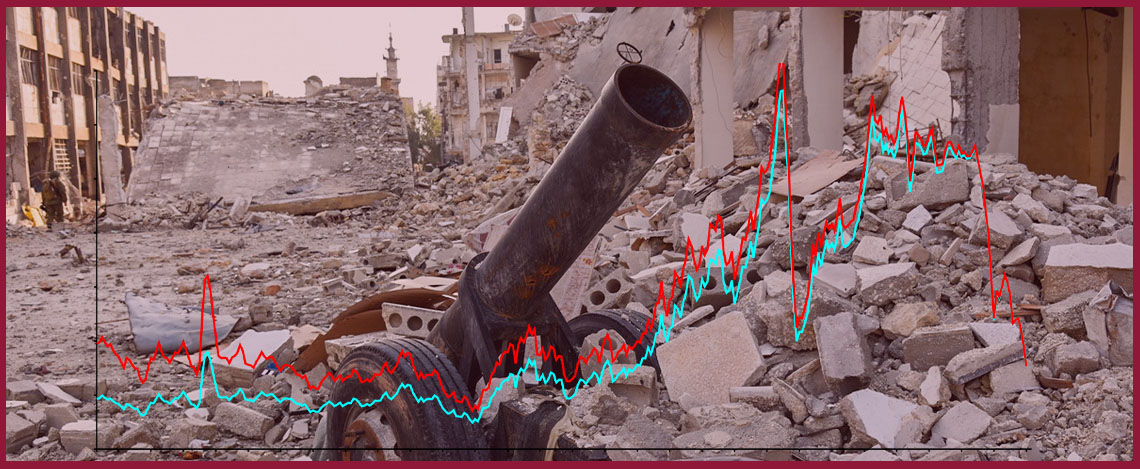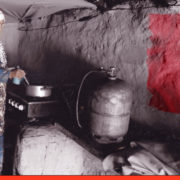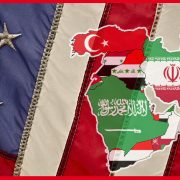According to the World Bank estimates, around two billion people live in fragile states or in states where development gains are severely affected or hindered by armed conflict.
Since the 1970s, not a single decade has passed without one or more Arab states having witnessed an internal crisis or an internal armed conflict lasting for several years and leaving thousands of victims. Meanwhile, the last decade has witnessed the largest and most detrimental internal armed conflicts in modern Arab history. Such conflicts naturally entail enormous economic, social and developmental losses.
This article aims to clarify the relationship between economic development ‒ or rather the lack of it ‒ and internal armed conflicts in the Arab world. The article focuses on addressing the role of development and other economic factors in the outbreak of armed conflicts, while leaving the economic and developmental repercussions of these conflicts to another article.
To begin, armed conflict in this context, refers to any intra-state conflict ‒ or a conflict within a state’s own territories ‒ resulting in the use of armed force between two groups or more, one of which is the government, and resulting in over 1,000 victims annually.[1]
Initially, the article begins by presenting the theoretical framework for the relationship between armed conflict and development status, supporting the analysis with empirical evidence. The article builds on this analysis to reflect on the current Arab situation in order to contribute to a more robust debate on the root causes of armed conflict in the MENA region and the means to overcome them.
Almost all scholars agree that there exists a mutually reinforcing relationship between armed conflict and economic development. The chronic failure of development policies may spark armed conflict. Conversely, armed conflicts do reverse decades of development gains.
As regards the first part of this relationship, the existing literature points to poor development outcomes being a fertile ground for the emergence and development of armed conflict drivers (see, for example, Collier & Hoeffler, 1998; Fearon & Laitin, 2003 Miguel et al., 2004; Hegre, 2015). More specifically, a number of manifestations of economic underdevelopment contribute to the formation of major drivers for armed conflicts.[2] Some of these manifestations are:
- Low income and low/stagnant economic growth: Stagnant economies and/or low average income over a number of years is a decisive factor in the eruption of armed conflicts. If national income in low-income countries falls to half the average income, the risk of civil war doubles. Whereas, every additional percentage point of economic growth reduces the possibility of civil war by an additional percentage point.[3]
- Income inequality: There is insufficient evidence to support the claim that armed conflict is the direct result of income inequality.[4] Nevertheless, evidence suggests that the likelihood of armed conflicts outbreak increases with increasing inequality and distribution of wealth among different groups, be them ethnic, religious or social.[5] This inequality ‒ which is group-based rather than individual-based ‒ is defined in economic literature as Horizontal Inequality.
- Low economic diversification: Heavy reliance on primary commodity exports and low levels of economic activity both increase the risk of civil war.[6] In particular, large fluctuations in the prices of raw materials globally lead to a state of income instability in the countries dependent mainly on exports of low value-added commodities. The distribution of income thus hinges on the stability of international markets, without which these countries are plunged into distress and are made vulnerable to food insecurity and violent social unrest.
- Previous history of armed conflict: A state’s previous exposure to armed conflict could be a strong determinant in the outbreak of armed conflict for a second time. One of the studies in this field found that countries emerging from armed conflict face a 44% chance of falling back into conflict during the first five years after the end of the conflict. Armed conflict contributes to creating or maintaining poor development conditions, which in turn fuel another round of armed conflict in what is widely known as the “conflict trap.”[7]
The assumption that armed conflict results from economic and developmental backwardness is quite common among a handful of economists. Yet, the claim has been disputed by researchers interested in armed conflict from other fields.[8] In particular, research in political science and sociology more broadly points to several interrelated motives for internal armed conflict, including identity, nationalism, authoritarian leadership, and institutional failure, in addition to psychological and security motives as well as geographical factors. However diverse, evidence does not entirely rule out the clear impact of the deteriorating economic and living conditions in the outbreak of armed conflict.
Some economists have tried to develop an integrated theory to explain the reasons behind certain motives ‒ and not others ‒ being the main instigator of armed conflict. They examined the impact of a number of economic, political, social and demographic factors on a large number of conflict and non-conflict countries, .[9]’[10] Some of these studies concluded that access to financial and military capabilities by marginalised groups has been a strong determinant of armed conflict. In the context of politico-economic imbalances ‒ this is commonly referred to as the “feasibility hypothesis”. In other words, regardless of the root causes or motives behind an armed conflict, whether it is political repression, social injustice or economic and institutional failure, the financial and military viability of the severely affected groups determines the possibility of these imbalances morphing into a civil war.
Access to financial and military capabilities by marginalised groups has been a strong determinant of armed conflict
Looking at the Arab region, on the one hand, poor economic and development conditions do not seem to be the most prominent factor in the outbreak of armed conflicts. Most Arab countries were classified as middle-income countries according to the World Bank before the outbreak of armed conflicts in them. Moreover, most of the Arab countries affected by conflict went through successive stages of economic growth, which spanned several years during the last period.
Likewise, income inequality is not considered exceptional in most Arab countries, nor is horizontal inequality. As is the case with average per capita income, many countries in Asia, Africa and Latin America are ranked lower than the Arab countries under consideration in this field. The same can apply to a wide range of key economic and social indicators. Nevertheless, most of these countries outside the Arab region have not experienced devastating internal conflicts, as is the case in some Arab countries. This is especially true for the conflicts of the last decade.
A claim often made is that states with low economic diversification are conflict-prone, such was the case in Iraq and Libya. However, such a claim lacks consistency because other Arab countries ‒ such as the Gulf States ‒ have managed to avoid the same fate even though they are also suffering from low economic diversification.
As regards previous conflicts experienced by a given state, this factor does not seem decisive either in the contemporary Arab case. Most Arab countries affected by the current conflicts, for instance, have not witnessed similar conflicts during the previous decade, if not even since earlier. Therefore, the armed conflict trap hypothesis cannot seem to stand unchallenged here.
On the other hand, no one can turn a blind eye to the existing political imbalances in most of the countries in this region, nor to the corruption that made a number of the Arab states rank in the bottom of the global integrity and transparency indexes.
However, the fact that a significant number of developing states ‒ despite sharing similar characteristics with conflict-torn Arab states ‒ are not affected by armed conflict refutes the claim that corruption on its own can explain armed conflict. For example, dozens of countries were below Syria, Yemen, and Libya in the 2010 Global Corruption Index, including Turkmenistan, Equatorial Guinea, Kenya, Venezuela, and Cambodia.
This applies, albeit to a lesser degree, to political freedom and the spread of democracy. The Democracy Index, published in the year 2010 by The Economist, shows that many countries were behind in the ranking compared to the Arab countries concerned. These include Iran, Equatorial Guinea, Central African Republic, Myanmar and Turkmenistan. Nevertheless, none of the aforementioned countries witnessed devastating conflicts such as those in the Arab region. Even if some of these states witnessed waves of social protests, such protests hardly amounted to a period of protracted unrest or left civilian victims.
The above analysis leaves a missing link in analysing the causes of the spread of devastating conflicts in the MENA region. Based on the assumptions made above about the motives behind the outbreak of armed conflict, the negative economic and development conditions, or even the political and institutional imbalances, are not significant enough to explain such armed conflicts of exceptional intensity currently experienced by a number of Arab states.
There remains a possibility, however, that the “feasibility hypothesis” referred to above will contribute to this interpretation. Even with the primary drivers of armed conflict, which of course are available – and perhaps more clearly – in a significant number of non-Arab countries that have not experienced armed conflict, the hypothesis is that defusing armed conflict requires meaningful financial resources and sufficient military support to ignite it. This happens most often through external support being provided to the affected groups.
Defusing armed conflict requires meaningful financial resources and sufficient military support to ignite it. This happens most often through external support being provided to the affected groups
A recent study strongly argues in favour of this hypothesis explaining the causes of conflict in our region.[11] The study, published by the Journal of Development Economics, examines the impact of ethnic and religious polarisation on civil wars in 138 countries and concludes that religious pluralism in the countries studied was not a decisive factor in the outbreak of civil wars except in the MENA region, and with the presence of external military intervention as a catalyst.
The interesting thing is, the study did not find evidence that ethnic and religious polarisation in this region exceeded the moderate limit. However, the conflicts witnessed have been quite intense and severe. It is interesting that this study was not carried out by one of the Arab research centers interested in the study of armed conflict, but by a researcher from Ben Gurion University, which shows the extent of the lack of Arab research efforts in this regard.
To sum up, the weakening economic and development conditions, and even the political and institutional imbalances, are not significant enough to explain simultaneous conflicts of exceptional intensity, such as those we are witnessing in many Arab countries.
On the other hand, the role of external interventions in stimulating the conditions conducive to the outbreak of internal armed conflicts appears clearer in our region compared to other regions where there are similar motives for these conflicts. Research-based evidence would place additional challenges before policy makers ‒ and even researchers, and civil society organisations ‒ to address the causes of internal armed conflicts in the Arab region as well as those relevant to development and economic growth, which have been deeply affected by these conflicts.
[1] This definition is also adopted by Uppsala Conflict Data Program (UCDP) at the Peace Research Institute Oslo (PRIO) https://www.pcr.uu.se/research/UCDP/.
[2] Paul Collier and Anke Hoeffler are two leading scholars arguing in favour of the ‘Motivation Theory’ in their 2004 study (Collier & Hoeffler 2004).
[3] See (Collier, 2008), (Collier & Hoeffler, 1998).
[4] See (Fearon & Laitin, 2003).
[5] See (Ray & Esteban, 2017).
[6] See (Collier, Hoeffler & Rohner, 2008) & (Fearon, 2005).
[7] See World Bank 2003 report (Collier et al., 2003).
[8] For evidence, see (Mac Ginty & Williams, 2016).
[9] See (Collier, Hoeffler & Rohner, 2008).
[11] See (Abo-Bader and Ianchovichina 2008).
References
Abu-Bader, Suleiman, and Elena Ianchovichina. 2019. Polarization, Foreign Military Intervention, and Civil Conflict 141.
Collier, P., Hoeffler, A., & Rohner, D. (2008). Beyond greed and grievance: Feasibility and civil war. Oxford Economic Papers, 61(1), 1–27. https://doi.org/10.1093/oep/gpn029
Collier, P. (2008). The bottom billion: Why the poorest countries are failing and what can be done about it. Oxford: Oxford University Press.
Collier, P., Elliott, V. L., Hegre, H., Hoeffler, A., Reynal-Querol, M., & Sambanis, N. (2003). Breaking the Conflict Trap: Civil War and Development Policy: The World Bank.
Collier, P., & Hoeffler, A. (1998). On Economic Causes of Civil War. Oxford Economic Papers, 50(4), 563–573. https://doi.org/10.1093/oep/50.4.563
Collier, P., & Hoeffler, A. (2004). Greed and grievance in civil war. Oxford Economic Papers, 56(4), 563–595. https://doi.org/10.1093/oep/gpf064
Eck, Kristine & Therése Pettersson (2018) Organized Violence, 1989-2017 and the Data Generation Process. Journal of Peace Research 55(4).
Fearon, J. D. (2005). Primary Commodity Exports and Civil War. Journal of Conflict Resolution, 49(4), 483–507. https://doi.org/10.1177/0022002705277544
Fearon, J. D., & Laitin, D. D. (2003). Ethnicity, insurgency, and civil war. American Political Science Review, 97(01), 75–90.
Gleditsch, Nils Petter; Peter Wallensteen, Mikael Eriksson, Margareta Sollenberg & Håvard Strand (2002) Armed Conflict 1946–2001: A New Dataset. Journal of Peace Research 39(5): 615–637.
Hegre, H. (2015). Civil conflict and development. In C. Lancaster & N. van de Walle (Eds.), Oxford handbooks online. The Oxford handbook of politics of development. [New York, N.Y.]: Oxford University Press.
Mac Ginty, R., & Williams, A. J. (2016). Conflict and development (Second edition). Routledge perspectives on development. London: Routledge.
Miguel, E., Satyanath, S., & Sergenti, E. (2004). Economic Shocks and Civil Conflict: An Instrumental Variables Approach. Journal of Political Economy, 112(4), 725–753. https://doi.org/10.1086/421174
Ray, D., & Esteban, J. (2017). Conflict and Development. Annual Review of Economics, 9(1).
Weinstein, J.M. (2005) Resources and the information problem in rebel recruitment, Journal of Conflict Resolution, 49, 598–624.
Visto International bears no responsibility for the content of the articles published on its website. The views and opinions expressed in these articles are those of the authors and do not necessarily reflect the official policy or position of the Organisation. All writers are encouraged to freely and openly exchange their views and enrich existing debates based on mutual respect.








